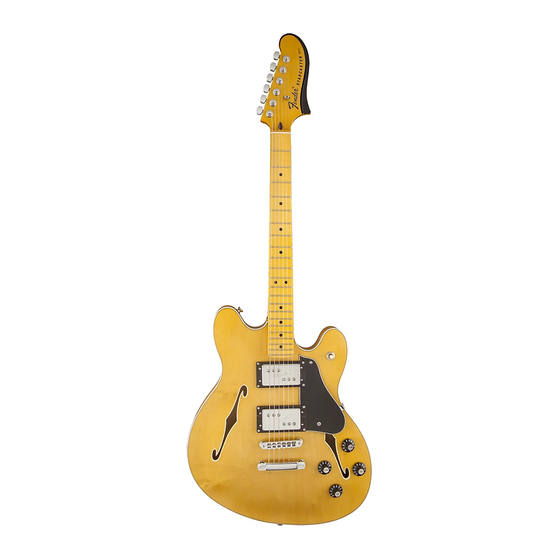- ページ 3
楽器 Fender StarcasterのPDF トラブルシューティングとセットアップマニュアルをオンラインで閲覧またはダウンロードできます。Fender Starcaster 6 ページ。 Fender starcaster: user guide
Fender Starcaster にも: オーナーズマニュアル (11 ページ)

STARCASTER
PACK
®
The following specifications are for guitars using the
standard gauges of Fender
®
is equipped with from the factory. Adjustments in these
specifications will need to be made if you plan to change
string gauges. Modifications of the specifications can also be
made (within limited parameters) to adjust for your individual
playing style or application, (i.e. how hard you pick, strum or
fret the guitar).
If you are not comfortable performing these adjustments
to your instrument, take it to an Authorized FMIC Service
Center for a "setup".
Note: Setups and adjustments are not covered under warranty.
Setup and Adjustment Made Easy
Weather, specifically temperature and humidity, may have
a dramatic impact on the way your instrument plays. All
instrument woods expand and contract with seasonal
fluctuations in temperature and humidity, and naturally,
string height and playing action are affected. Depending
on the climate where you live, your instrument may need
routine adjustments a few times a year.
Starcaster instruments have several points of adjustment
which are there to control the effects of these environmental
changes, and more importantly, these features allow you to
tailor the action of the instrument to your own personal
playing style.
Note: The following factory specifications are minimum specs,
and are meant only to guide you. They should not to be taken as
hard and fast rules. If you want your action higher, set it higher!
SETUP GUIDE
strings that the instrument
Truss-Rod Adjustment
String tension exerts a tremendous bending force on the
neck of the instrument. The adjustable steel truss rod in the
neck employs a counter-force to the pull of the strings. If
these two opposing forces are not in harmony with each other,
the result will be a poorly playing instrument. Note: A truss
rod that is too loose will result in a concave neck bow and high
action
A truss rod that is too tight will result in a
(Figure A).
convex neck bow and buzzing strings
Figure A.
Concave "Bow" (Exaggerated View)
Figure B.
Convex "Hump" (Exaggerated View)
Figure C.
Measuring relief with feeler gauge
To check the adjustment of the truss rod, first tune your
instrument to pitch. Next, attach a capo at the 1 st fret. For
electric guitars and basses, depress the "E" string at the last
fret. For acoustic guitars depress the "E" string at the 14th
fret. With the feeler gauge, check the gap between the bottom
of the string and the top of the 8th fret
(See the relief specification chart on the next page for the proper gap.)
.
(Figure B)
.
(Figure C)
